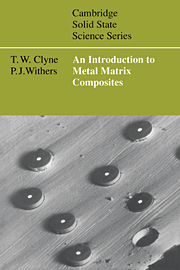Book contents
- Frontmatter
- Contents
- Preface
- 1 General introduction
- 2 Basic composite mechanics
- 3 The Eshelby approach to modelling composites
- 4 Plastic deformation
- 5 Thermal effects and high temperature behaviour
- 6 The interfacial region
- 7 Fracture processes and failure mechanisms
- 8 Transport properties and environmental performance
- 9 Fabrication processes
- 10 Development of matrix microstructure
- 11 Testing and characterisation techniques
- 12 Applications
- Appendix I Nomenclature
- Appendix II Matrices and reinforcements – selected thermophysical properties
- Appendix III The basic Eshelby S tensors
- Appendix IV Listing of a program for an Eshelby calculation
- Author index
- Subject index
10 - Development of matrix microstructure
Published online by Cambridge University Press: 04 February 2010
- Frontmatter
- Contents
- Preface
- 1 General introduction
- 2 Basic composite mechanics
- 3 The Eshelby approach to modelling composites
- 4 Plastic deformation
- 5 Thermal effects and high temperature behaviour
- 6 The interfacial region
- 7 Fracture processes and failure mechanisms
- 8 Transport properties and environmental performance
- 9 Fabrication processes
- 10 Development of matrix microstructure
- 11 Testing and characterisation techniques
- 12 Applications
- Appendix I Nomenclature
- Appendix II Matrices and reinforcements – selected thermophysical properties
- Appendix III The basic Eshelby S tensors
- Appendix IV Listing of a program for an Eshelby calculation
- Author index
- Subject index
Summary
Initially, suitable matrix alloy compositions and heat treatments were proposed solely on the basis of experience gained with unreinforced alloys. However, as this chapter demonstrates, the incorporation of a reinforcing phase can have a pronounced effect on the development of matrix microstructure. Because of their sensitivity to matrix microstructure, this is an especially important consideration for discontinuously reinforced systems.
Dislocation structure and behaviour
Plastic deformation in the matrix of a composite is never completely homogeneous. The reinforcement interrupts flow, giving rise to distinctive dislocation structures. As well as having immediate implications for the flow properties of the matrix, these structures also indirectly influence flow behaviour via changes in the precipitation and aging response.
The influence of thermal stress on dislocation structure
In many MMCs, thermal stresses can give rise to dislocation densities which are 10–100 times greater than those for comparable unreinforced alloys. The conditions under which the creation of thermally stimulated dislocations is energetically favourable were first studied by Ashby and Johnson, who found that, for incoherent particles, the critical misfit decreases with increasing particle size. For short fibres and particles, the simplest mechanism of stress relief is to punch out a dislocation loop (a disc of vacancies or interstitials) into the matrix (Fig. 10.1(a,b)). This mechanism, illustrated schematically in Fig. 4.16, is well understood in terms of a relaxation in the local stress field.
- Type
- Chapter
- Information
- An Introduction to Metal Matrix Composites , pp. 370 - 398Publisher: Cambridge University PressPrint publication year: 1993
- 2
- Cited by

